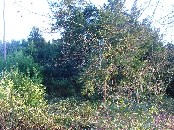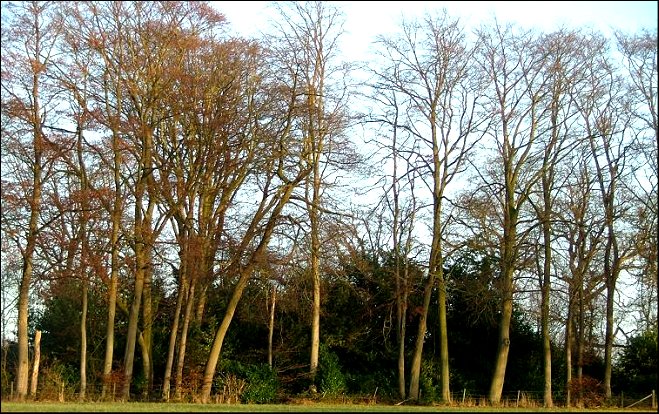| |
|
All
Saints, Letton Mid-January, and the first bright, sunny day
of the year. You might almost think that Spring was on
its way, but Norfolk was in for a long haul yet. Now, in
the late afternoon, we had one more task before heading
back to Norwich; to locate the site of the church of All
Saints, Letton.
We knew
that it was in the former grounds of Letton Hall. The
Gurdons, who lived at the Hall, were great patrons of the
church at Cranworth, which became their parish church
after the demise of All Saints, and they also paid for
the rebuilding of Southburgh. It did occur to me that All
Saints might have been demolished because it was on
private ground, and the Big Family hadn't wanted the
ordinary folk on their land. In which case, it might be
still be private land, and awkward for us to explore it.
Given that
fieldwork might not be an option, we used the Ordnance
Survey map to locate what appeared to be the site, and it
seemed as if it would be visible from the Cranworth road.
There was a rectangular copse of trees set at an angle to
the road, with the parkland of the Letton Hall estate
around it. However, when we got there we found that to
the west of the site was an open field, with no fence or
ditch between it and the road. There was no sign telling
us to keep out, but there is also no designated public
access and so I cannot really encourage you to follow in
our footsteps.
I gazed
across at the trees. Near to the boundary, a fallow deer
lazily lifted its head from where it was cropping the
close grass. I raised my camera and flicked the shutter
on, but it saw us, and wandered off quickly into the
copse.
The air
was cold, a mist beginning to rise as the sun sunk behind
us. Letton Hall, now an evangelical Christian retreat
centre, shone on its rise, and all about was the thump!
thump! of shotguns. The shooting party appeared to
be the woods to the north, about a quarter of a mile
away; I hoped that they wouldn't be in the copse we hoped
to explore. A 4x4 stood sentry at the entrance to the
field, suggesting that this was where they had started.
| We
walked a few hundred yards across the field until
we reached the fence. Although it was barbed
wire, it had been broken down, and so we stepped
over it into the wood. To be
honest, it was rather a creepy place. Apart from
a line of beech trees along the boundary, the
copse was boiling in rhododendron bushes, a relic
from the aristocratic gardening enthusiasm of a
couple of centuries ago. More recently, a path
had been cut through the bushes - for the
shooting party? - but the thickets were so dense
it was impossible to say what might be within
them.
|
|
 |
All Saints
was there at the end of the 11th century, when the
Domesday Book recorded the presence of a church in the
parish. Then, Letton consisted of half a carucate of
land. A carucate is the amount of ground a single
ploughing team could manage in an annual cycle - that is,
Letton was not a large place. There was woodland for
eight pigs, and meadowland of 8 acres. Looking back
across the meadow, it was hard to think that anything had
changed much, except that the church was gone.
After the
Reformation, the church seems to have fallen into disuse.
By the early 19th century, the living had been combined
with that of Cranworth. In 1844, Whites noted that the
church of All Saints had been dilapidated many years
ago, and its site marked by a plantation. Dilapidated
is a polite way of saying that the Gurdons demolished it.
Pevsner
recorded in the late 1950s that the foundations of the
church could still be discerned above ground level. It is
possible that he never saw this for himself, but is
repeating someone else's observation. Bill Wilson repeats
the description in the 1999 revision; but again, he
usually says if he has been to check an observation of a
ruin, and in this entry he doesn't. In which case, the
foundations may have been lost to sight for a half
century or more. We peered under the thickets, hoping for
a glimpse of a flint wall or a pile of stone, but there
was nothing.
It was
only as we were leaving, and stepping back into the open
field, that I looked back and saw what I should have
noticed earlier. To the south of the rhododendron
clusters were overgrown thickets of yew trees;
straggling, tangled with later wild growth, but
immediately recognisable as the familiar residents of
many Norfolk graveyards. Suddenly, it all fell into
place; the beeches marked the boundary of the plantation
that had replaced the churchyard, the yew trees showed
where the yard was to the south of the church, and the
church itself had been where the rhododendrons are now.
They were the only recent growth, but even they had been
there for a hundred years or more.
Quietly
satisfied, we wandered back down to the road. The 4x4 was
still there, the guns still thumping down in the woods.
Simon Knott, January 2006
|
|
|

